
The Bottom Line
Introduction, Drive Specifications, Pricing & Availability
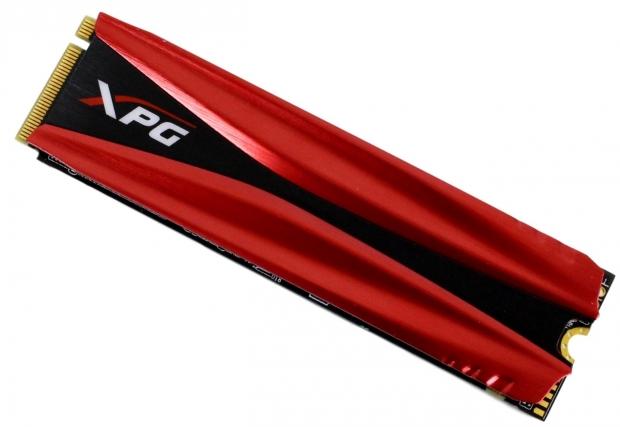
ADATA's XPG Gammix S10 M.2 NVMe SSD is aimed toward value-conscious buyers that are looking for more than SATA can offer for about the same price. The XPG Gammix S10 delivers on price and unexpectedly delivers in a big way on aesthetics. The XPG Gammix S10 is in our opinion the best-looking M.2 NVMe SSD we've ever seen.
The XPG Gammix S10 has an integrated, eye-catching and very functional heat sink. This heat sink is a bit more practical than some of the larger ones that we've seen before. The sleek-looking XPG Gammix S10 looks and feels like it would have a high price-tag, but it is very affordable. In-fact it is the most affordable 4-lane NVMe SSD on the market.
The XPG Gammix is configured similarly to Intel's popular 600p series NVMe SSDs. The main difference between the 600p and the XPG Gammix is a huge one. They both utilize SMI's SM2260 NVMe controller and Gen1 IMFT 32-layer TLC flash, but the XPG Gammix S10 is utilizing all 8-channels available on the SMI SM2260. The 600p only utilizes six of the 8 available channels and to make matters worse, the 600p employs oddball 384Gbit die 32-layer Gen1 IMFT flash. This unfortunate combination results in the 600p being the lowest performing NVMe SSD we've ever tested.
Fortunately, ADATA did not repeat Intel's mistake with the XPG Gammix S10. The XPG Gammix S10 utilizes the SM2260's available 8-channels and pairs it with 256Gbit IMFT 3D TLC flash. Now, this combination isn't going to light up our charts, but it is far superior to the Intel 600p's configuration. The XPG Gammix S10 is targeted at those of you that are looking for more performance than SATA has to offer at a super-low price point. In this respect, we think ADATA hit the mark perfectly with the XPG Gammix S10.
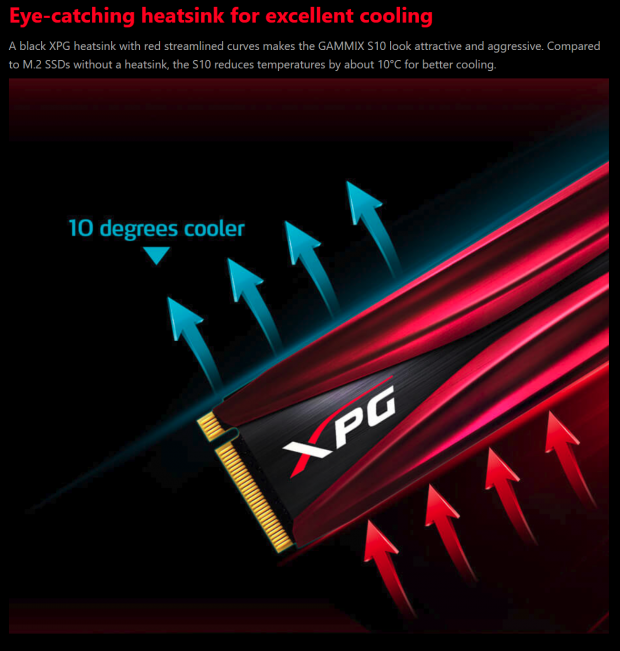
That flashy heat-sink is eye-catching, but it is also functional. ADATA claims that the aluminum heat-sink utilized on the XPG Gammix S10 reduces temperatures by about 10c in comparison to M.2 SSDs without a heat sink. The red and black heat-sink should be a perfect color combination for most builds. Additionally, we really like the way the heat-sink adds a bit of heft to the drive making it feel like a quality piece of hardware.
The XPG Gammix S10 provides additional value for purchasers with included Acronis cloning software as well as full compatibility with ADATA's SSD Toolbox. The SSD Toolbox allows you to monitor drive health, update firmware, secure erase the drive, and optimize your system for SSD use. Both Acronis and ADATA's SSD Toolbox are available via free downloads from ADATA. These value adds and super-low retail cost, in our opinion, make the XPG Gammix S10 one of the best values on the market today.
Let's get the XPG Gammix S10 on the bench and see exactly what kind of performance it is serving up.
Specifications
ADATA's XPG Gammix S10 Series is available in four capacities: 128GB, 256GB, 512GB, and 1TB.
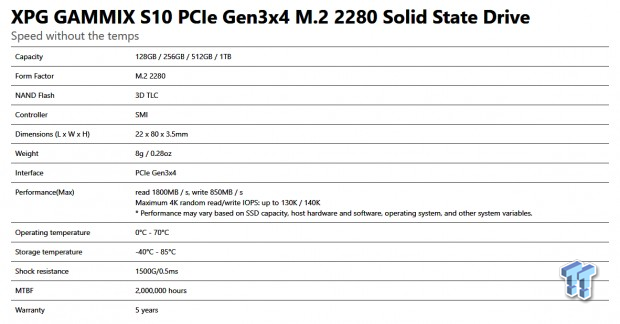
- MTBF: 5 Million Hours
- Warranty: 5-Year Limited Warranty
- SLC caching
- LDPC
- SMART
- TRIM
- End-to-End Datapath Protection
- Garbage Collection
The 512GB ADATA XPG Gammix S10 we have on the bench is currently retailing for $165.
Drive Details
ADATA XPG Gammix S10 512GB M.2 PCIe NVMe SSD
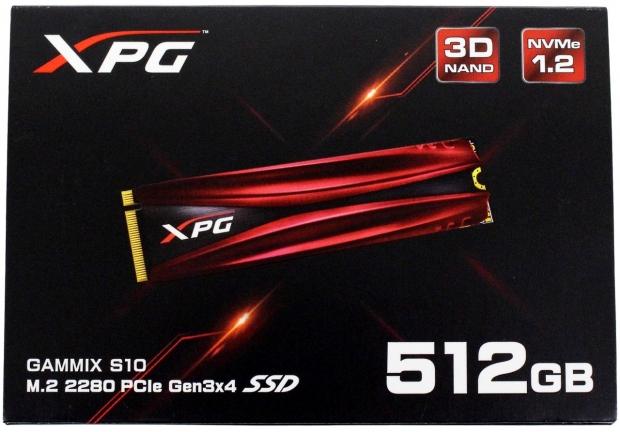
The front face of the colorful packaging advertises the XPG Gammix S10's form-factor and interface. There is an image of the enclosed SSD on the front.
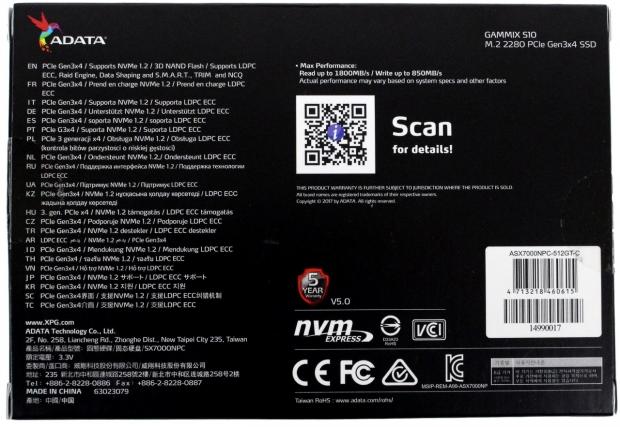
The back of the packaging advertises "up to" sequential performance, LDPC ECC, features, its form-factor and 5-year limited warranty.
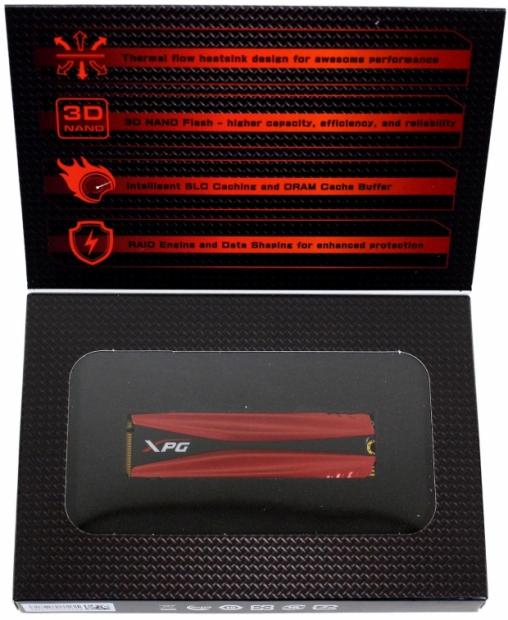
The drive is visible through a transparent plastic window.
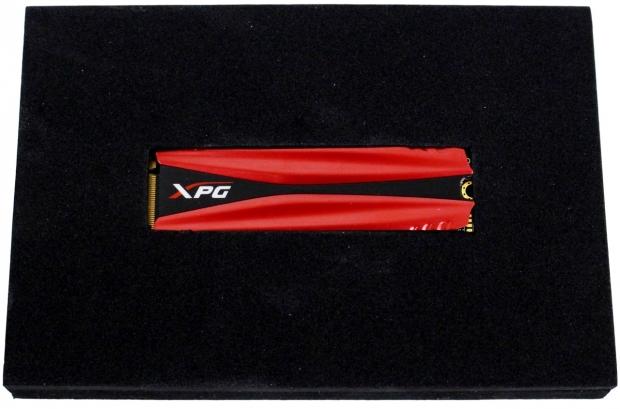
The drive is well protected by piece of dense foam.

This side of the drive features that gorgeous heat-sink. The heat-sink is attached with adhesive thermal pads. We are not going to pry the heat sink off, but we can tell you what is under it. Underneath the heat-sink is a SMI SM2260 8-channel controller a 256MB Nanya DDR3 DRAM package and two 128GB flash packages.

This side of the PCB houses another 256MB Nanya DDR3 DRAM package and two more 128GB flash packages.
Test System Setup, Drive Properties
Jon's Consumer PCIe SSD Z270 Intel Review Test System Specifications
- Motherboard: ASRock Z270 Taichi - Buy from Amazon / Read our review
- CPU: Intel Core i7 7700K @ 5.0GHz - Buy from Amazon / Read our review
- Cooler: Swiftech H2O-320 Edge - Buy from Amazon / Read our review
- Memory: Corsair Vengeance LPX DDR4 16GB 3200MHz - Buy from Amazon
- Video Card: Onboard Video
- Case: IN WIN X-Frame - Buy from Amazon / Read our review
- Power Supply: Seasonic Platinum 1000 Watt Modular - Buy from Amazon / Read our review
- OS: Microsoft Windows 10 Professional 64-bit - Buy from Amazon
We would like to thank ASRock, Crucial, Intel, Corsair, RamCity, IN WIN, and Seasonic for making our test system possible.
Drive Properties
ADATA XPG Gammix S10 512GB M.2 PCIe NVMe SSD OS Disk 75% Full
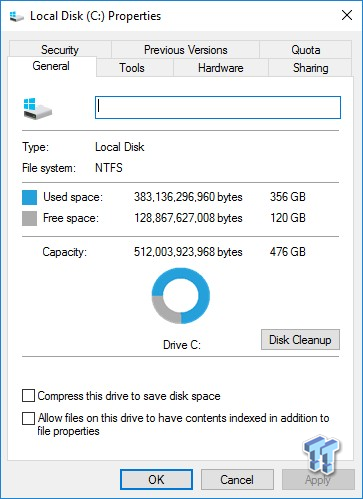
The majority of our testing is performed with our test drive as our boot volume. Our boot volume is 75% full for all OS Disk "C" drive testing to replicate a typical consumer OS volume implementation.
We feel that most of you will be utilizing your SSDs for your boot volume and that presenting you with results from an OS volume is more relevant than presenting you with empty secondary volume results.
System settings: Cstates and Speed Stepping are both disabled in our system BIOS. Windows High-Performance power plan is enabled. Windows write caching is enabled, and Windows buffer flushing is disabled.
We are utilizing Windows 10 Pro 64-bit OS (Build 14393) for all our testing except for our MOP (Maxed-Out Performance) benchmarks where we switch to Windows Server 2008 R2 64-bit. Empty Windows 10 benchmark screenshots will also be shown on our MOP page.
Please note: When comparing our results to those of other review sites, look at page 10 Maxed Out Performance-Windows 10 which is done with the disk empty.
Synthetic Benchmarks - ATTO & Anvil Storage Utilities
ATTO
Version and / or Patch Used: 3.05
ATTO is a timeless benchmark used to provide manufacturers with data used for marketing storage products. When evaluating ATTO performance we focus on the drive's performance curve.
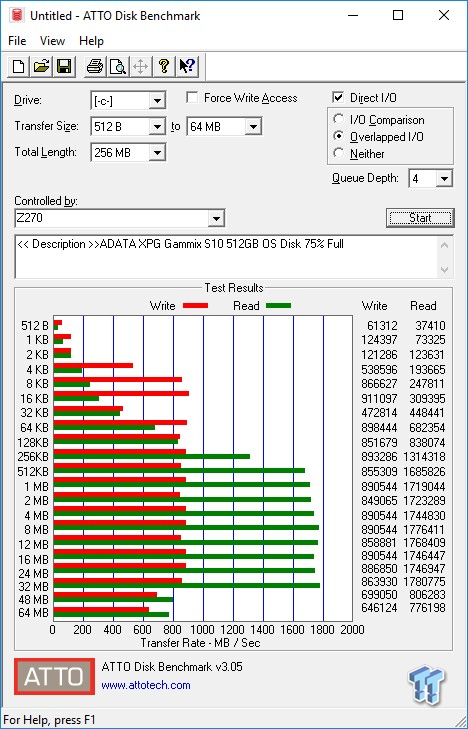
We are not able to match factory sequential read performance when the drive is 75% full. Keep in mind that factory sequential speeds are measured at QD32; we are running this test at QD4.
Sequential Write
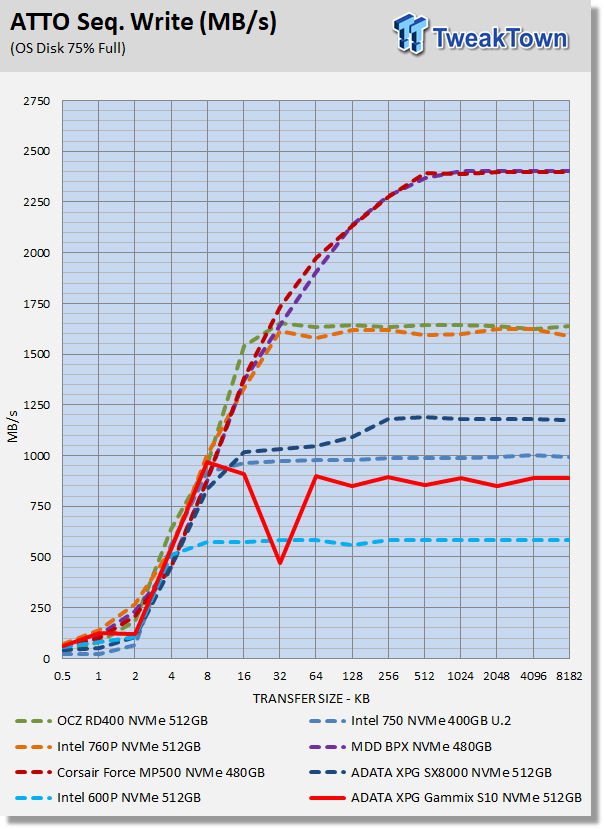
The XPG Gammix S10 easily outperforms Intel's 600p. We note especially good performance with transfers of 4KB-8KB.
Sequential Read
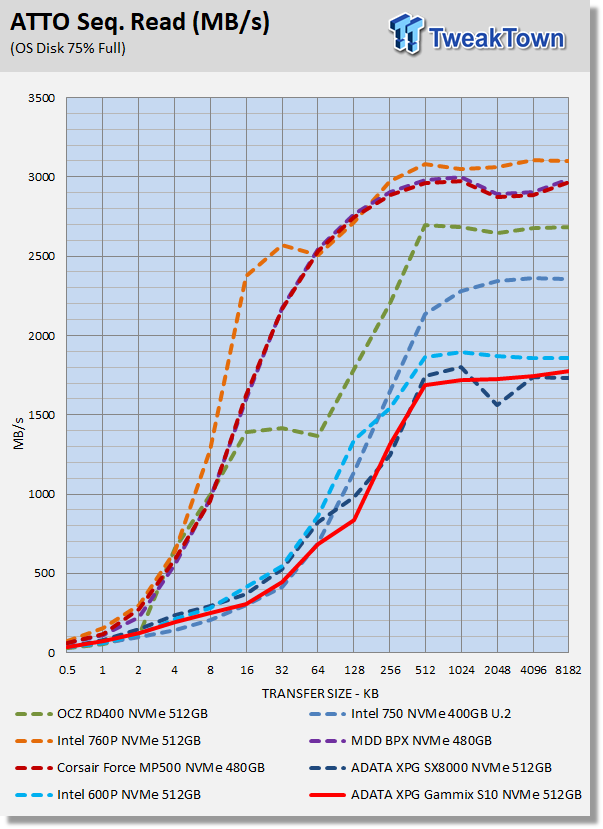
Sequential read performance ramps up slowly. The XPG Gammix S10 trades blows with the SX8000 for last place. Even the worst NVMe SSD of all-time (600p) gets the better of the XPG Gammix S10 in this test.
Anvil Storage Utilities
Version and / or Patch Used: 1.1.0
Anvil's Storage Utilities is a storage benchmark designed to measure the storage performance of SSDs. The Standard Storage Benchmark performs a series of tests; you can run a full test or just the read or write test, or you can run a single test, i.e. 4K QD16.
When evaluating performance with Anvils, we focus on total score. When evaluating NVMe SSDs we are typically looking for a minimum total score of 10K. We place a greater importance on read performance than write performance.
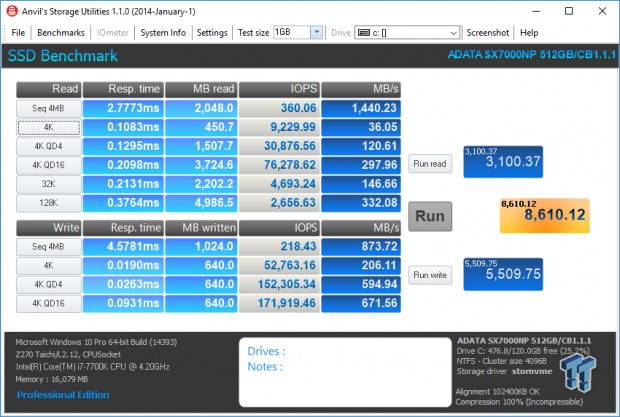
We don't get our 10K, but still a decent total score for the price. Definitely a huge upgrade from SATA.
Scoring
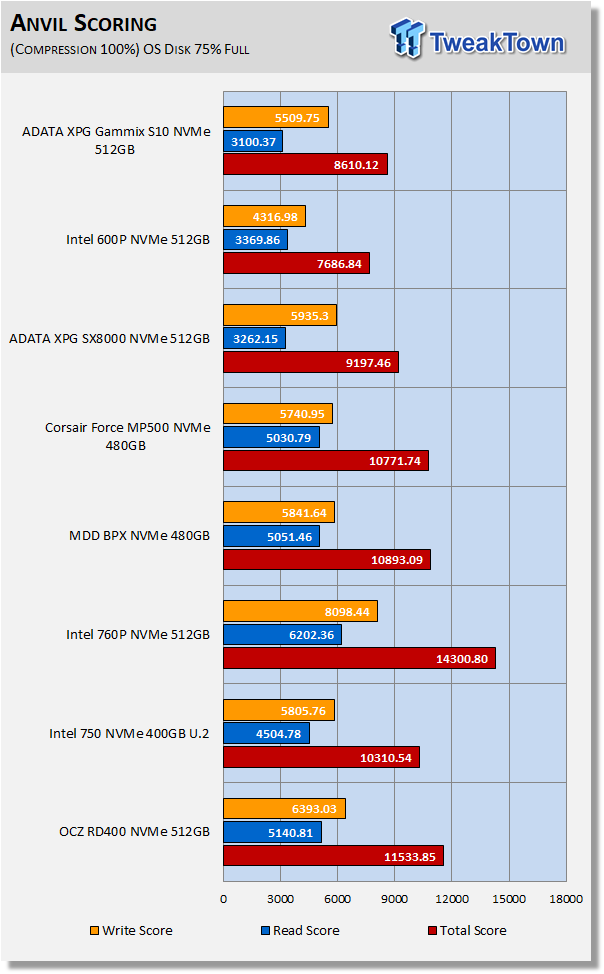
In terms of total score, the XPG Gammix S10 soundly defeats the 600p. The XPG Gammix S10 comes close to matching the much more expensive SX8000. We would like to see better random read performance from the XPG Gammix S10.
(Anvil) Read IOPS through Queue Depth Scale
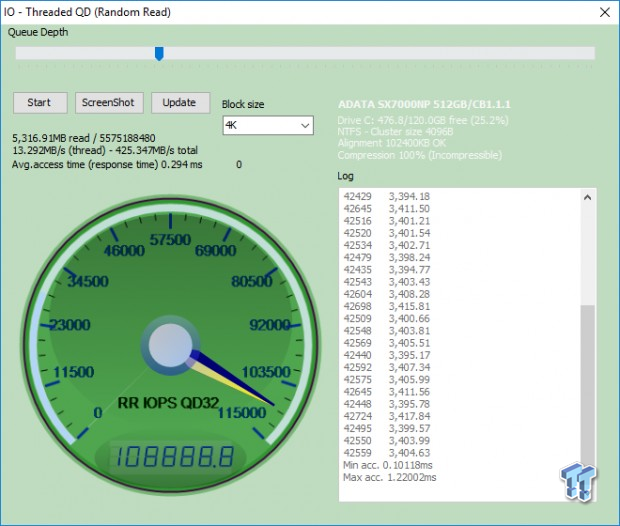
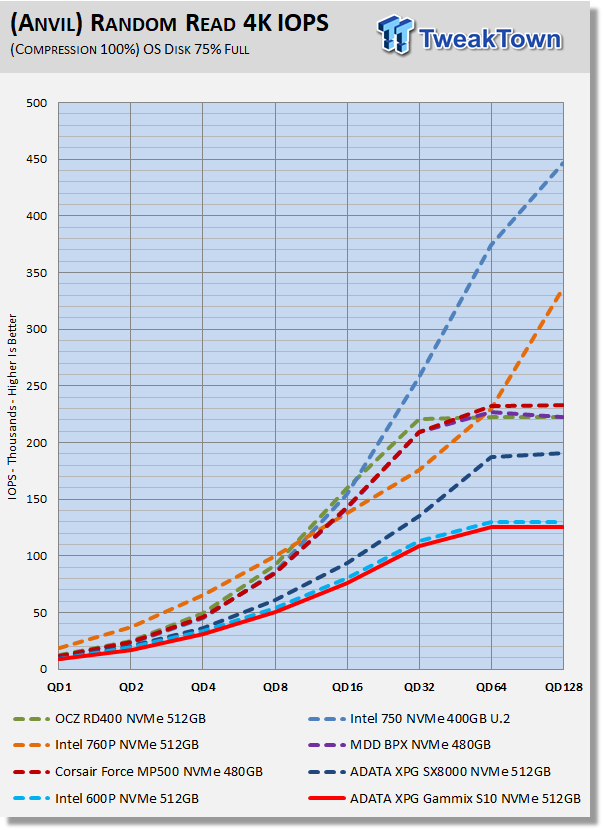
Again, we would like to see better random read performance from the XPG Gammix S10.
(Anvil) Write IOPS through Queue Scale
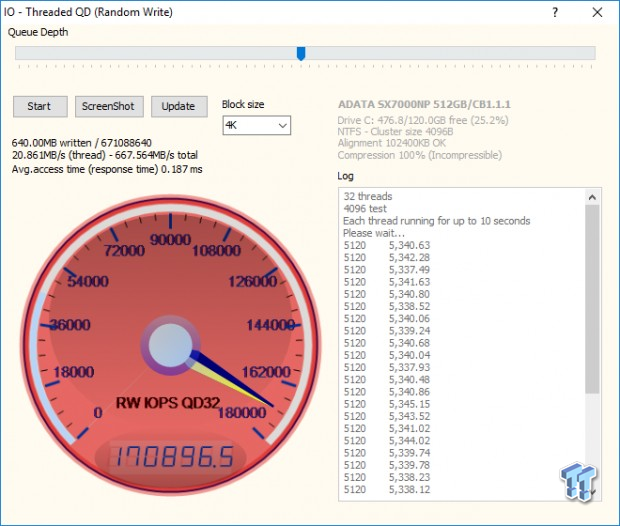
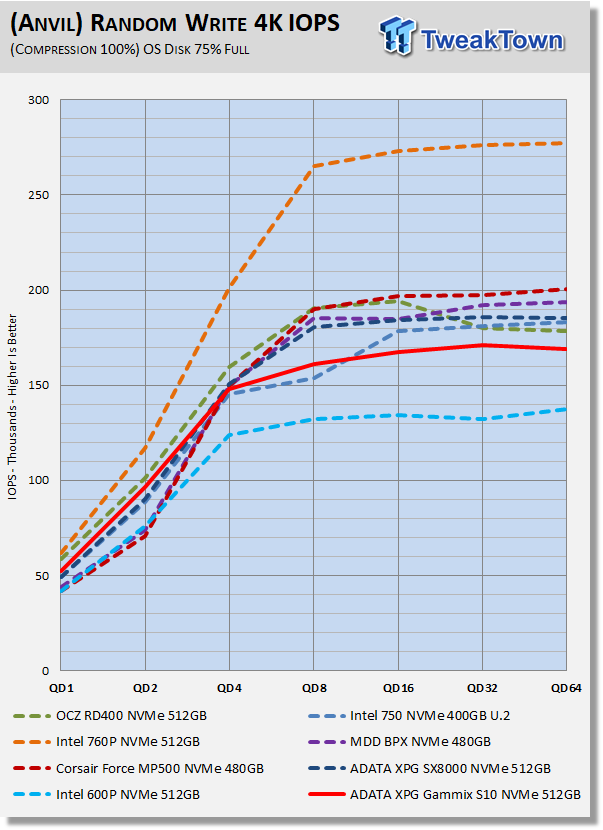
At low queue depths, where performance matters most, the XPG Gammix S10 performs very well. It outperforms most of the contenders in our test pool at QD1-4.
Synthetic Benchmarks – CrystalDiskMark & AS SSD
CrystalDiskMark
Version and / or Patch Used: 3.0 Technical Preview
CrystalDiskMark is disk benchmark software that allows us to benchmark 4k and 4k queue depths with accuracy. Note: Crystal Disk Mark 3.0 Technical Preview was used for these tests since it offers the ability to measure native command queuing at QD4. When evaluating CDM results, we focus on 4K random performance at QD1 and QD4.

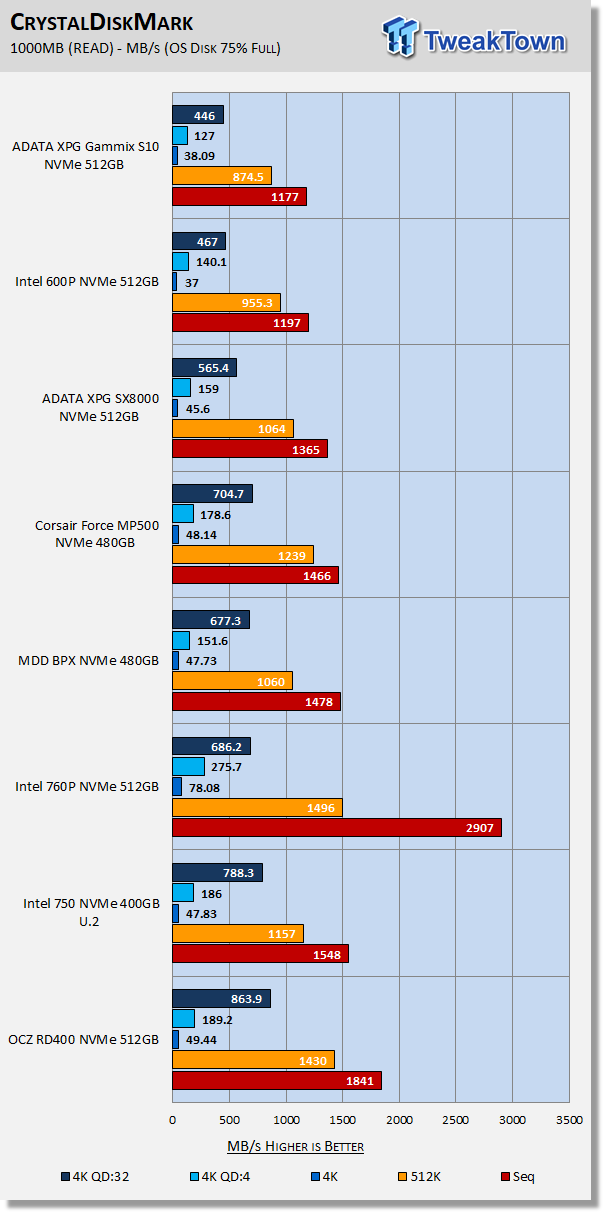
Focusing in on QD1 and QD4 we find the XPG Gammix S10 lagging behind the rest of the contenders in our test pool. Here again, the lowly 600p has a slight advantage.
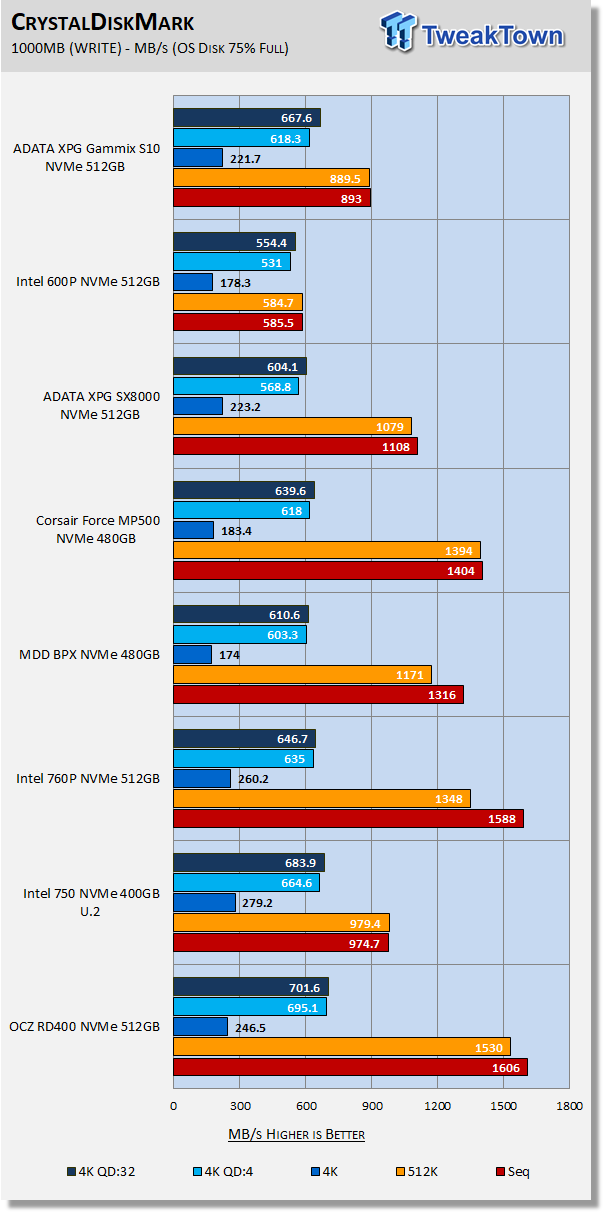
Writing random data at low queue depths is what the XPG Gammix S10 likes best. It is able to best several of the contenders in our test pool.
AS SSD
Version and / or Patch Used: 1.8.5611.39791
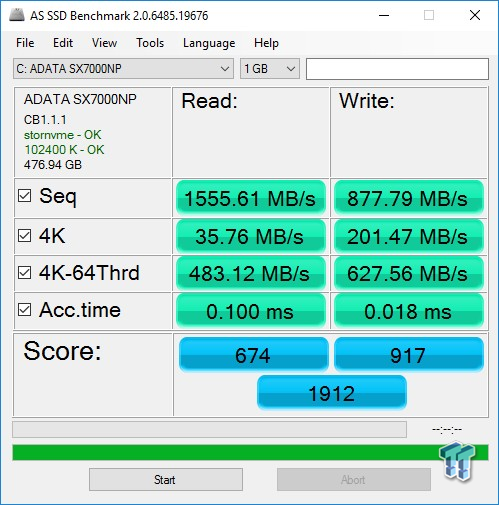
AS SSD determines the performance of SSDs. The tool contains four synthetic as well as three practice tests. The synthetic tests are to determine the sequential and random read and write performance of the SSD. We evaluate AS SSD performance in terms of overall score. We are looking for a minimum score of 2,000 when evaluating NVMe SSDs.
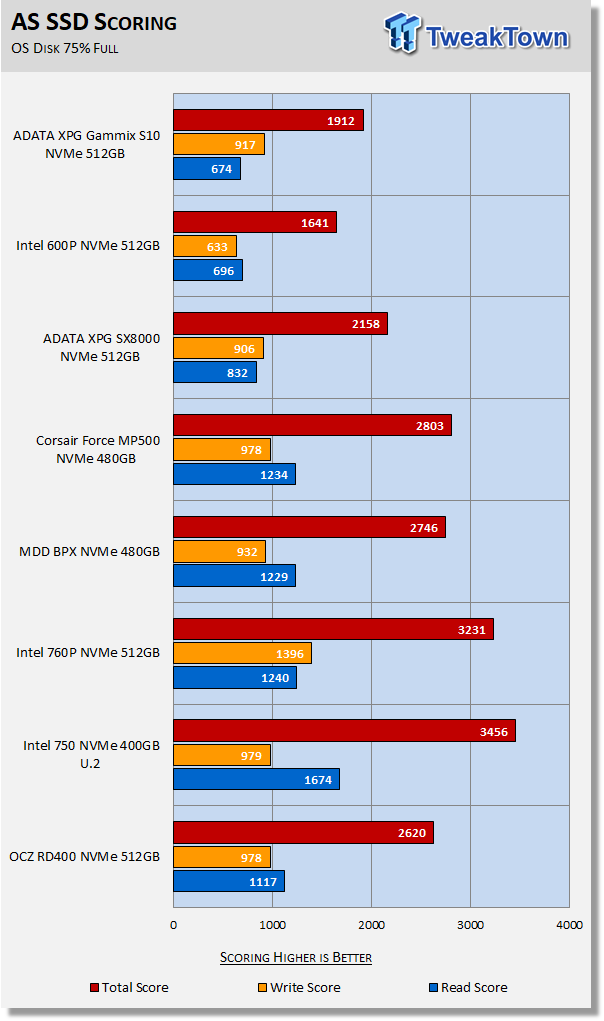
We don't get our 2K minimum, but we are pleased to see the XPG Gammix S10 taking the 600p to the woodshed. Keep in mind that the XPG Gammix S10 is priced lower than the Intel 600p.
Benchmarks (OS) - Vantage, PCMark 7, PCMark 8 & SYSmark 2014 SE
Moderate Workload Model
We categorize these tests as indicative of a moderate workload environment.
PCMark Vantage - Hard Disk Tests
Version and / or Patch Used: 1.2.0.0
The reason we like PCMark Vantage is because the recorded traces are played back without system stops. What we see is the raw performance of the drive. This allows us to see a marked difference between scoring that other trace-based benchmarks do not exhibit. An example of a marked difference in scoring on the same drive would be empty vs. filled vs. steady state.
We run Vantage three ways. The first run is with the OS drive 75% full to simulate a lightly used OS volume filled with data to an amount we feel is common for most users. The second run is with the OS volume written into a "Steady State" utilizing SNIA's consumer guidelines.
Steady-state testing simulates a drive's performance similar to that of a drive that been subjected to consumer workloads for extensive amounts of time. The third run is a Vantage HDD test with the test drive attached as an empty, lightly used secondary device.
OS Volume 75% Full - Lightly Used
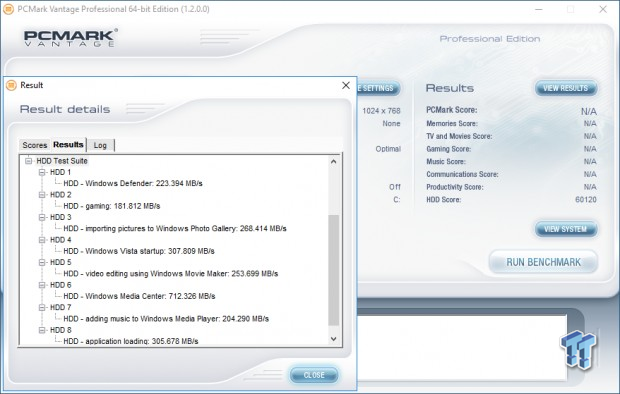
OS Volume 75% Full - Steady State
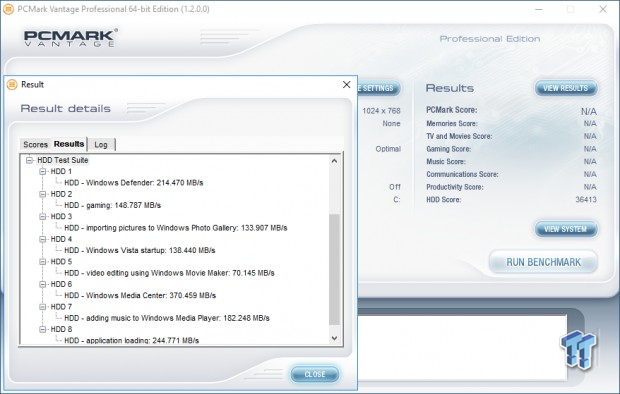
Secondary Volume Empty - FOB
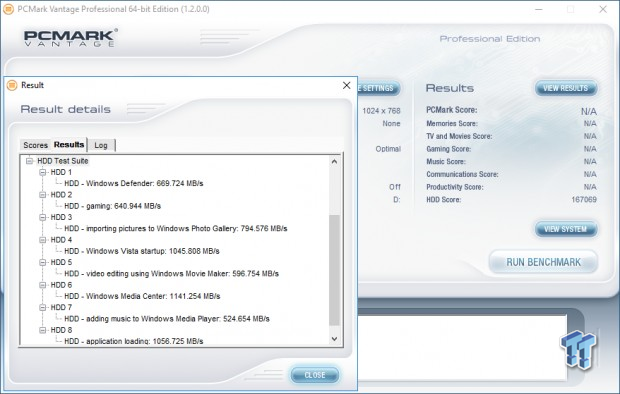
There's a big difference between an empty drive, one that's 75% full/used, and one that's in a steady state.
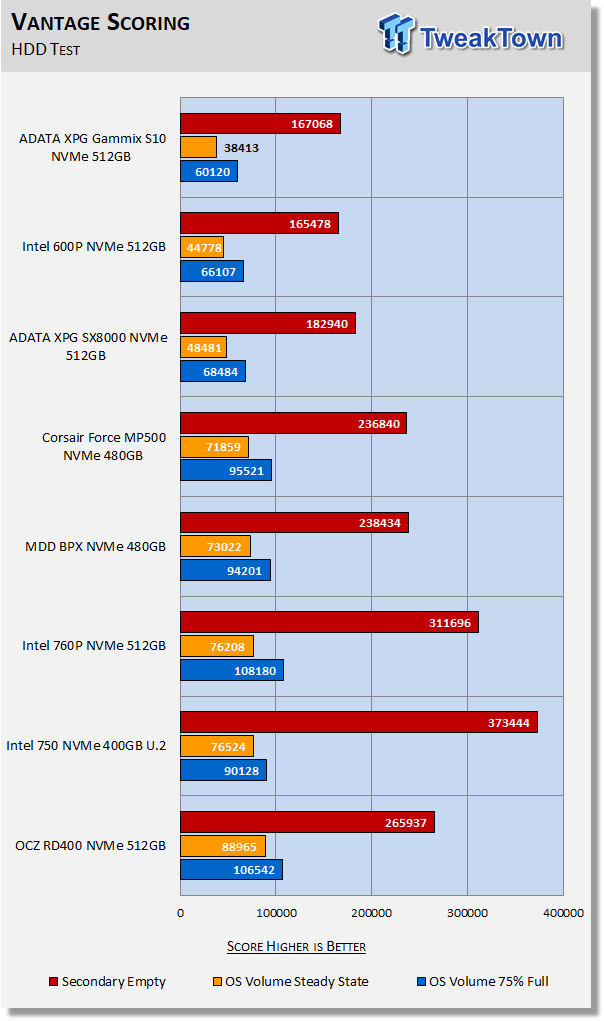
The important scores to pay attention to are "OS Volume Steady State" and "OS Volume 75% full." These two categories are most important because they are indicative of typical of consumer user states. When a drive is in a steady state, it means garbage collection is running at the same time it's reading/writing.
Focusing in on 75% full, we find the XPG Gammix bringing up the rear. The 600p is able to do a bit better because it has a significant about of OP helping it to sustain performance in this test.
PCMark 7 - System Storage
Version and / or Patch Used: 1.4.0
We will look to Raw System Storage scoring for evaluation because it's done without system stops and, therefore, allows us to see significant scoring differences between drives. When evaluating NVMe SSDs we are looking for a minimum score of 11,000.
OS Volume 75% Full - Lightly Used
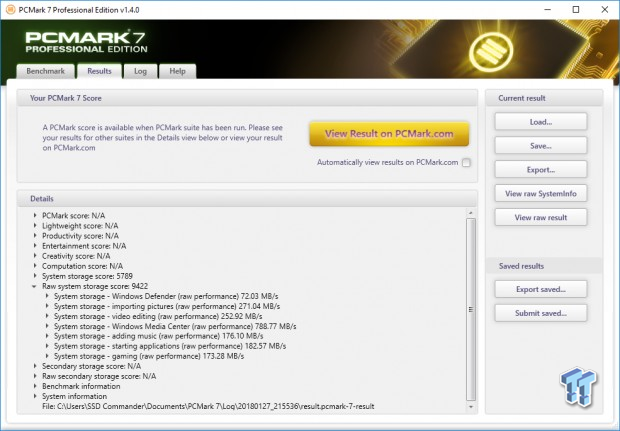
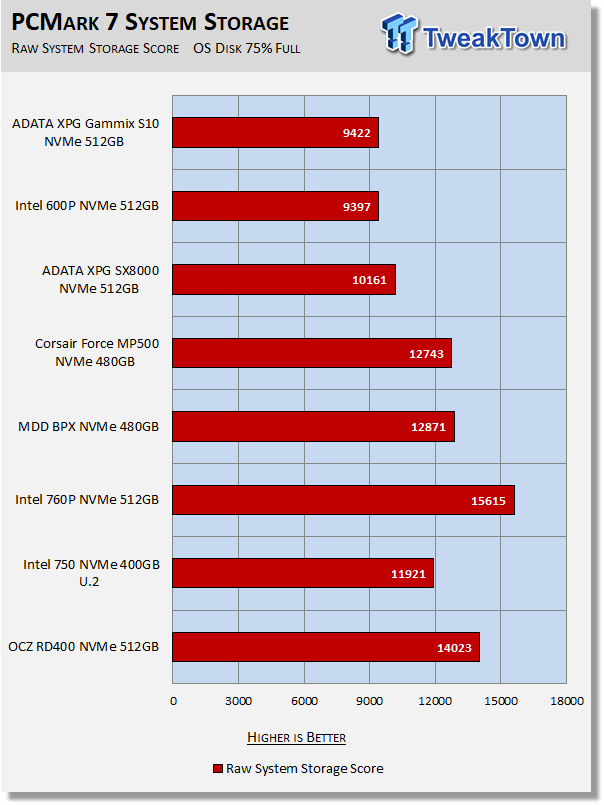
The XPG Gammix S10 is able to best Intel's 600p. This is where it matters most, moderate consumer workloads.
PCMark 8
Version and / or Patch Used: 2.4.304
We use PCMark 8 Storage benchmark to test the performance of SSDs, HDDs, and hybrid drives with traces recorded from Adobe Creative Suite, Microsoft Office, and a selection of popular games. You can test the system drive or any other recognized storage device, including local external drives.
Unlike synthetic storage tests, the PCMark 8 Storage benchmark highlights real-world performance differences between storage devices. We focus on the total score first and then storage bandwidth when evaluating PCMark 8 results.
OS Volume 75% Full - Lightly Used
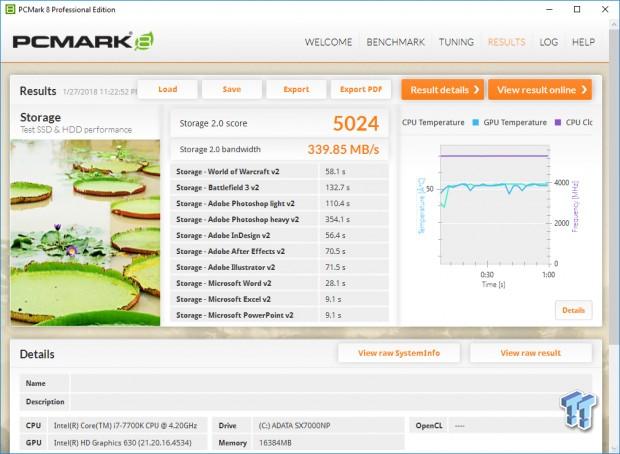
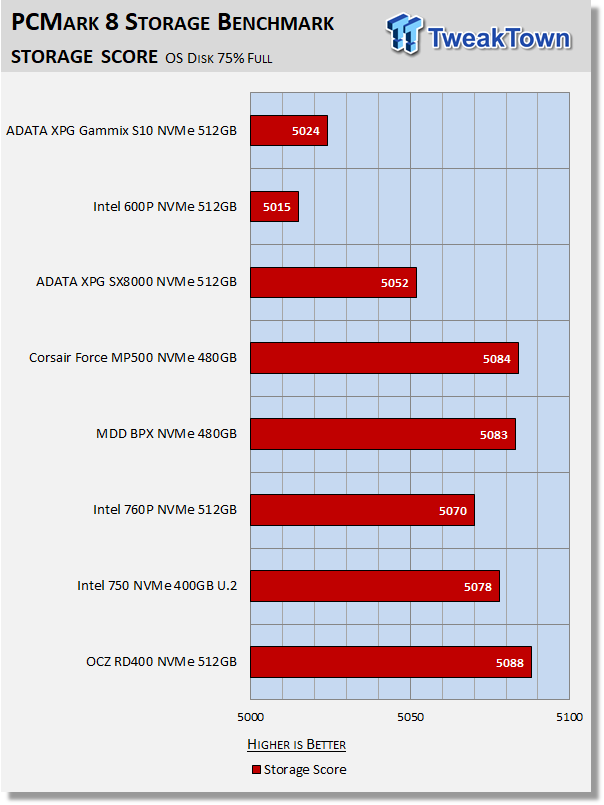
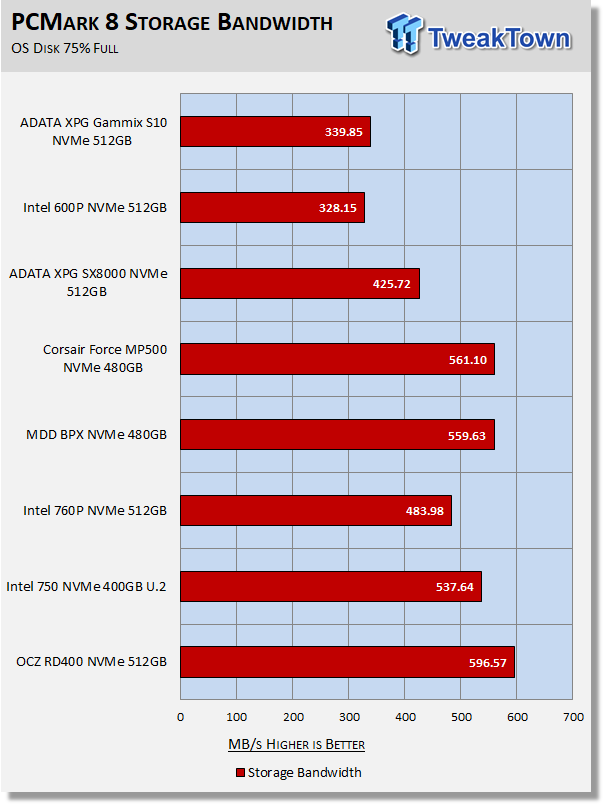
PCMark 8 is the most intensive moderate workload simulation we run. With respect to moderate consumer type workloads, this test is what we consider the best indicator of a drive's sustained consumer workload performance. Again, the XPG Gammix S10 gets the better of the 600p.
BAPCo SYSmark 2014 SE Application Performance
Version and / or Patch Used: 2.0.0.70
SYSmark 2014 SE is considered the gold standard for testing system performance because it is an application based benchmark.
This test gives us the ultimate in real-world results because it utilizes actual applications running on the system, instead of playing back recorded traces. If you want to know what kind of impact a particular SSD will have on your system's overall performance; this test will show you.
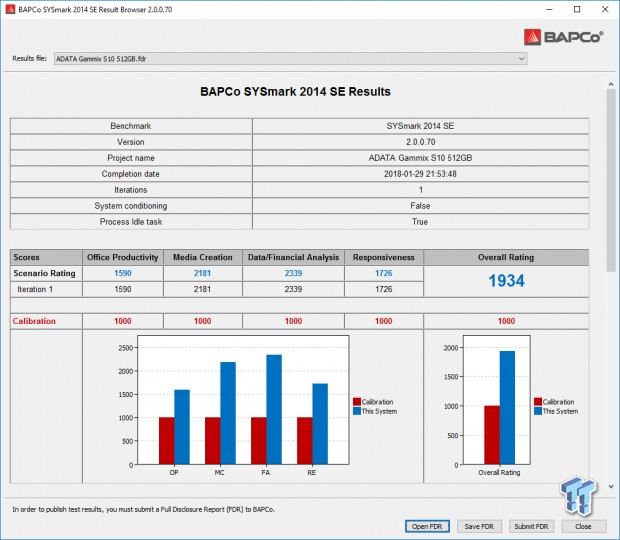
Our systems are much more powerful than the calibration system (1000-point baseline) used by BAPCo, so we ran an OCZ TL100 120GB SATA III SSD to establish a comparison point relative to our test systems. We will be running this test going forward and we will add drives to our chart as we test them.
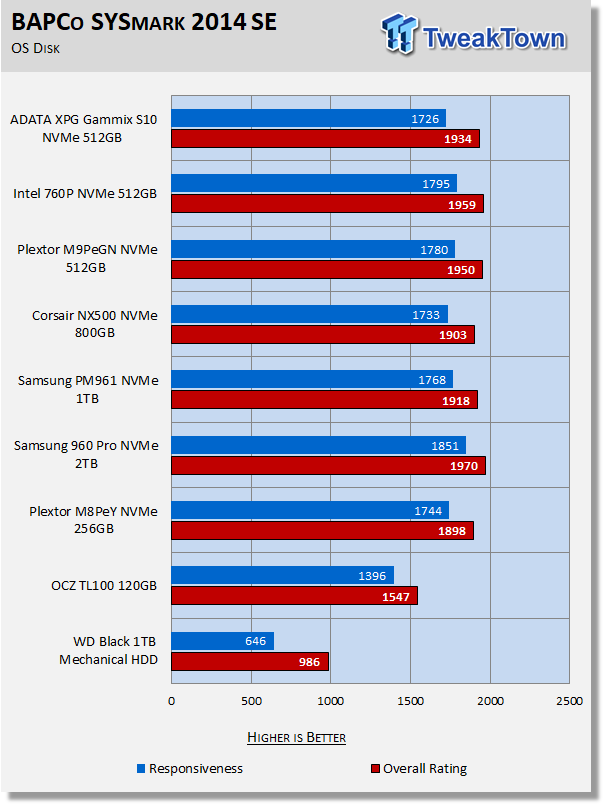
This testing shows that without a doubt the XPG Gammix S10 is perfectly capable of delivering great system performance. The Gammix delivers the goods just as well as the much more expensive MP500. We did not test the Intel 600p with SYSMark, but we are certain that if we did, the Gammix would show itself to be the better choice.
Benchmarks (Secondary) - IOPS, Response & Transfer Rate
Iometer - Maximum IOPS
Version and / or Patch Used: Iometer 2014
We use Iometer to measure high queue depth performance. (No Partition)
Max IOPS Read
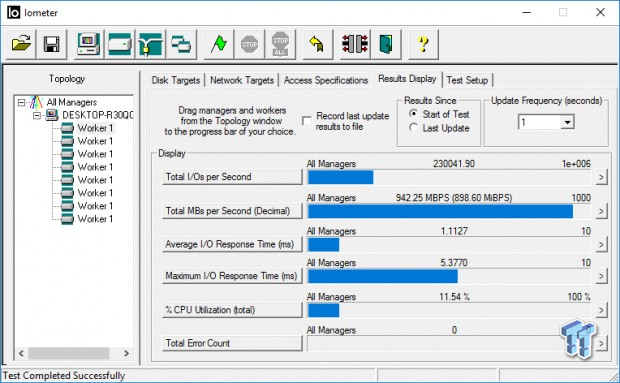
Max IOPS Write
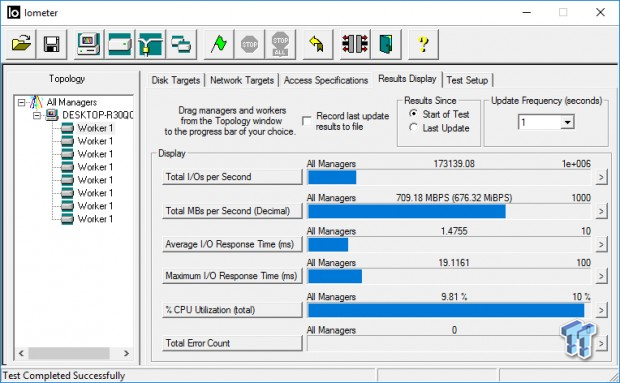
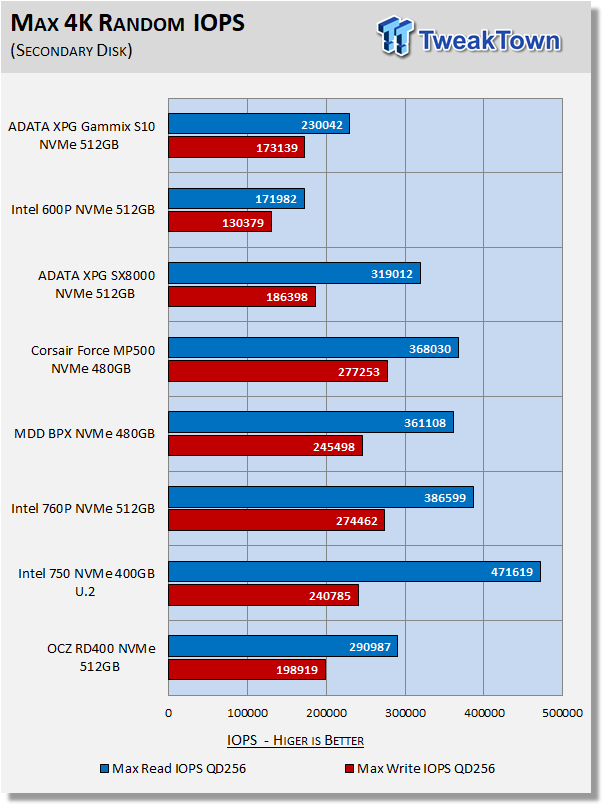
We test NVMe SSDs using eight threads at QD32, or QD256. We do this because we want to see what the drive can generate at its maximum attainable queue depth.
Iometer - Disk Response
Version and / or Patch Used: Iometer 2014
We use Iometer to measure disk response times. Disk response times are measured at an industry accepted standard of 4K QD1 for both write and read. Each test runs twice for 30 seconds consecutively, with a 5-second ramp-up before each test. We partition the drive/array as a secondary device for this testing.
Avg. Write Response
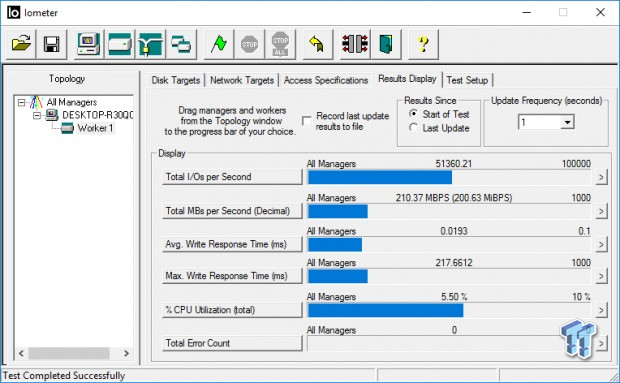
Avg. Read Response
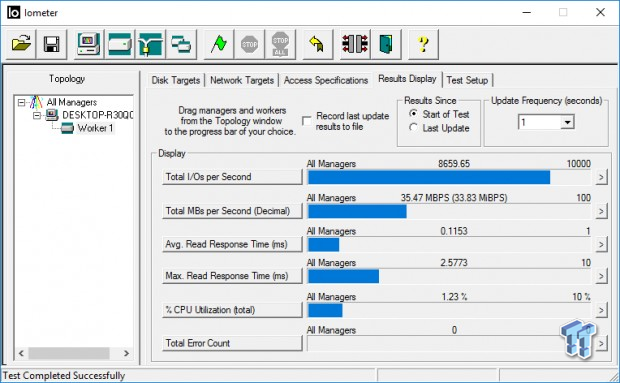
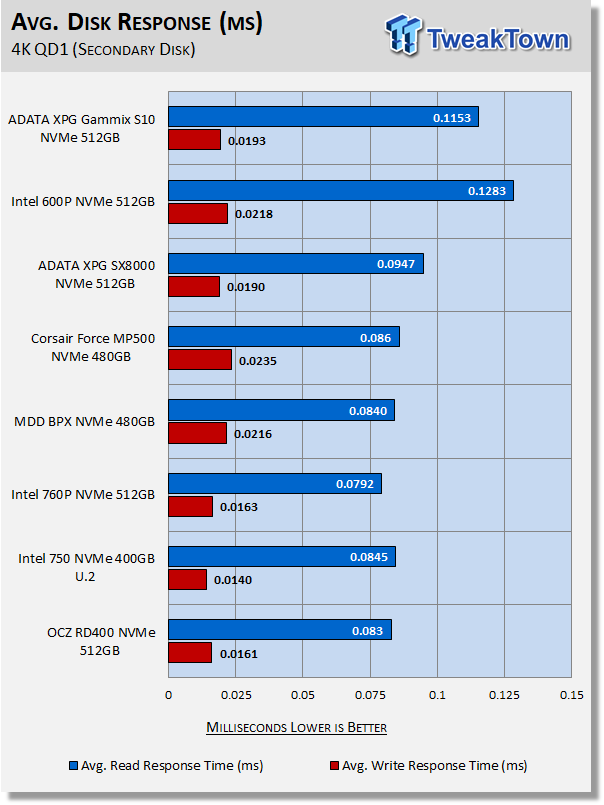
Not only is the XPG Gammix S10 cheaper than the Intel 600p, again we see the Gammix delivering significantly better performance.
DiskBench - Transfer Rate
Version and / or Patch Used: 2.6.2.0
We use DiskBench to time a 28.6GB block (9,882 files in 1,247 folders) composed primarily of incompressible sequential and random data as it's transferred from our Toshiba RD400 1TB NVME SSD to our test drive.
We then read from a 6GB zip file that's part of our 28.6GB data block to determine the test drive's read transfer rate. Our system is restarted prior to the read test to clear any cached data, ensuring an accurate test result.
Write Transfer Rate
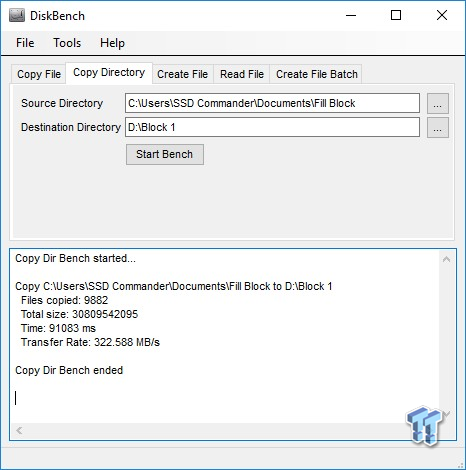
Read Transfer Rate
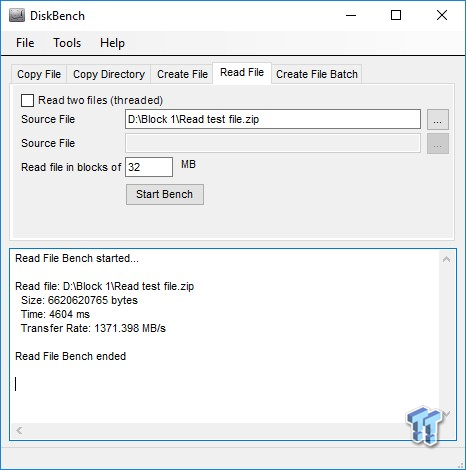
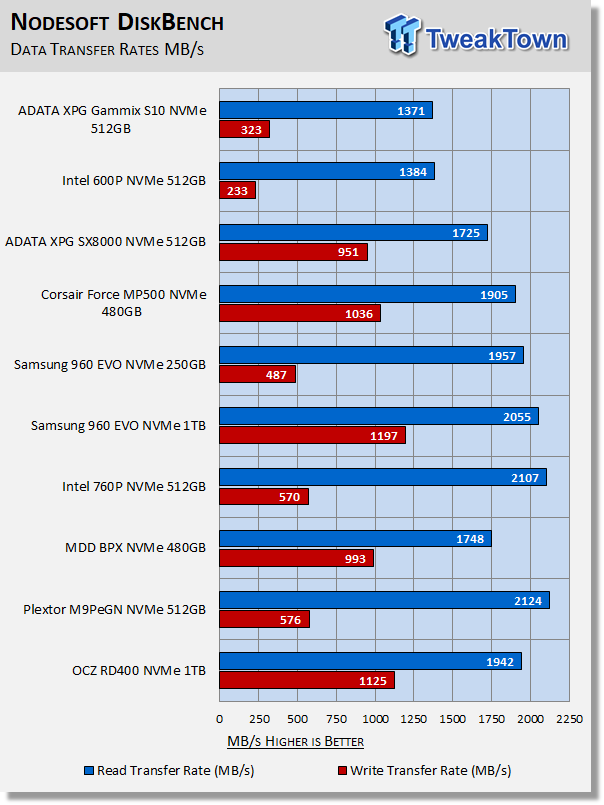
We recently upgraded our test system to Windows 10 build 14393. With that upgrade, write transfer rates almost doubled. The reason for this, as far as we know, is that CPU power switching modes have been relaxed on the latest version of Windows 10. We included the NVMe drives we've tested to date on this build of Windows 10. If you needed a good reason to upgrade to a newer version of Windows 10; this is a good reason.
Here is the main weakness of the XPG Gammix S10 on display. Sustaining large write blocks at a high transfer rate is just not in the cards for Gen1 IMFT TLC flash. 323 MB/s is slow, slower than a typical SATA SSD, but it's still nearly 50% better than we are getting from Intel's popular 600p 512GB.
Benchmarks – 70/30 Mixed Workload & Sustained Sequential Write
70/30 Mixed Workload Test (Sledgehammer)
Version and / or Patch Used: Iometer 2014
Heavy Workload Model
This test hammers a drive so hard we've dubbed it "Sledgehammer". Our 70/30 Mixed Workload test is designed to simulate a heavy-duty enthusiast/workstation steady-state environment. We feel that a mix of 70% read/30% write, full random 4K transfers best represents this type of user environment. Our test allows us to see the drive enter into and reach a steady state as the test progresses.
Phase one of the test preconditions the drive for 1 hour with 128K sequential writes at QD32. Phase two of the test runs a 70% read/30% write at QD32, full random 4K transfer workload on the drive for 1 hour. We log and chart (phase two) IOPS data at 5-second intervals for 1 hour (720 data points). 60 data points = 5 minutes.
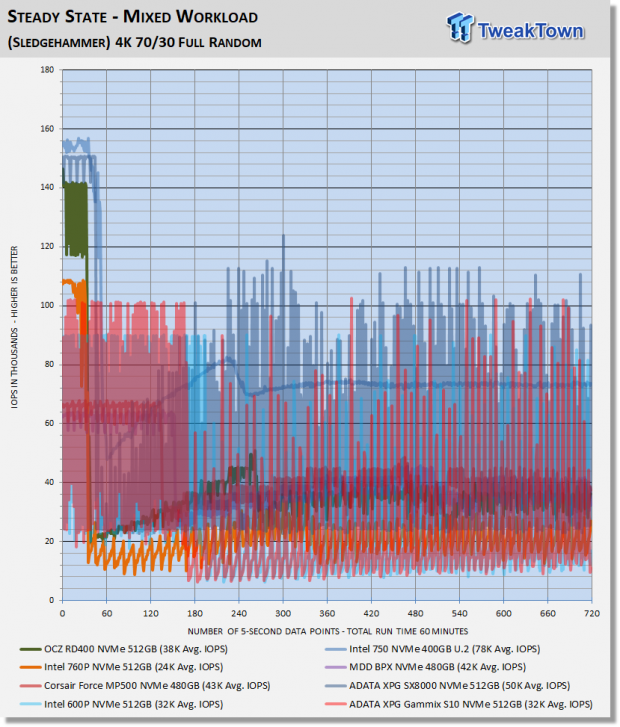
What we like about this test is that it reflects reality. Everything lines up, as it should. Consumer drives don't outperform Enterprise-Class SSDs that were designed for enterprise workloads. Consumer drives based on old technology are not outperforming modern Performance-Class SSDs, etc.
Actually, this is very good sustained performance for an SSD that doesn't have any OP.
Sustained Sequential Write
Version and / or Patch Used: Iometer 2014
Heavy Workload Model
We write to the drive for 1 hour with 128K sequential writes at QD32. We log and chart megabytes per second data at 5-second intervals for 1 hour (720 data points). 60 data points = 5 minutes.
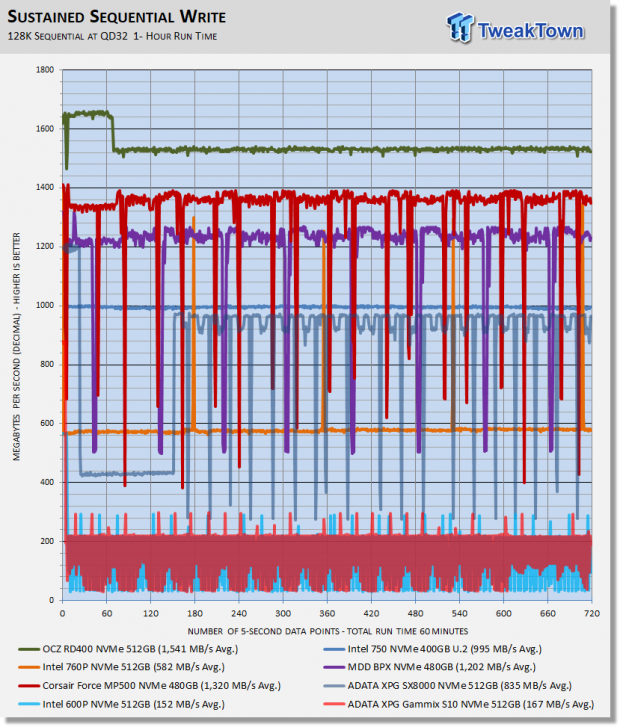
Like our transfer test, this test unmasks the sequential write performance of TLC flash arrays. The 512GB Gammix S10 sustains writes at 167 MB/s which is pretty bad. Even so, it's still a bit better than we are getting from the 600p.
Maxed-Out Performance (MOP)
This testing is just to see what the drive is capable of in an FOB (Fresh Out of Box) state under optimal conditions. We are utilizing empty volumes of Windows 10 and Windows Server 2008 R2 64-bit for this testing.
Windows 10 MOP
ADATA XPG Gammix S10 512GB M.2 PCIe NVMe SSD
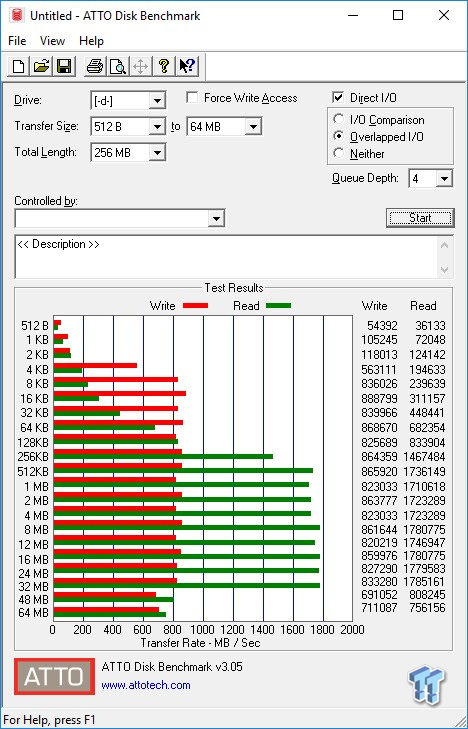

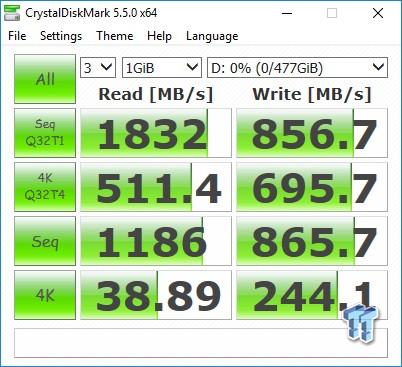

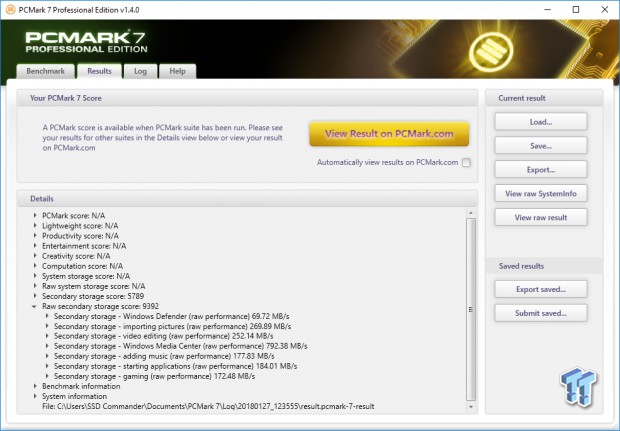
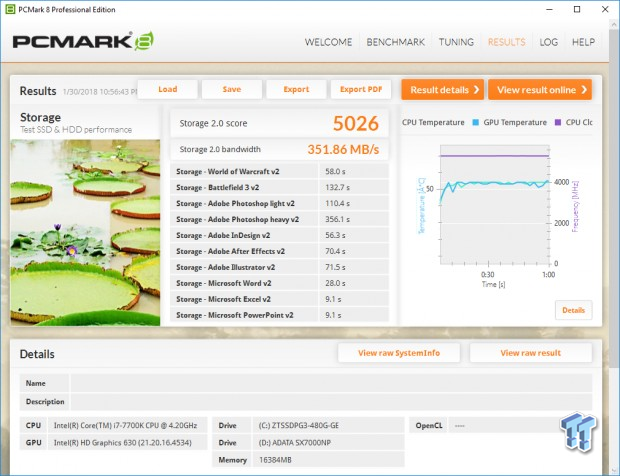
Windows Server 2008 R2 MOP
ADATA XPG Gammix S10 512GB M.2 PCIe NVMe SSD
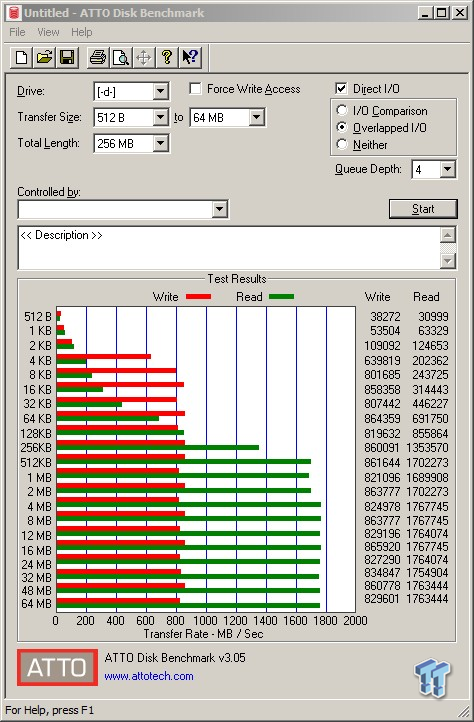
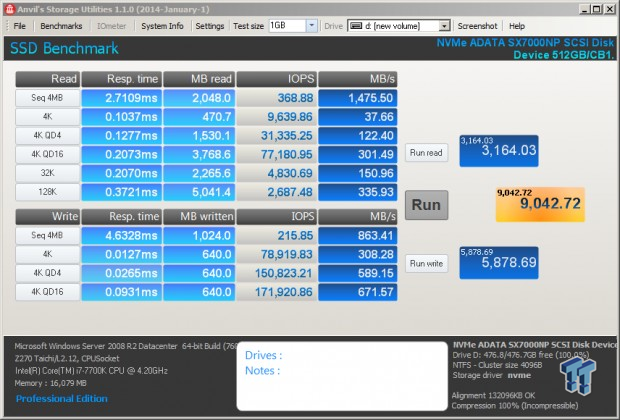
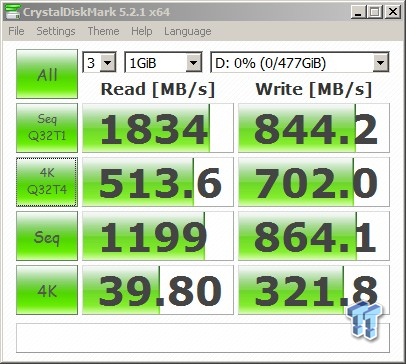
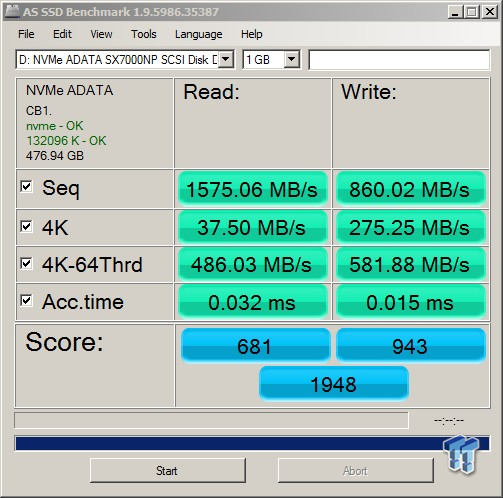
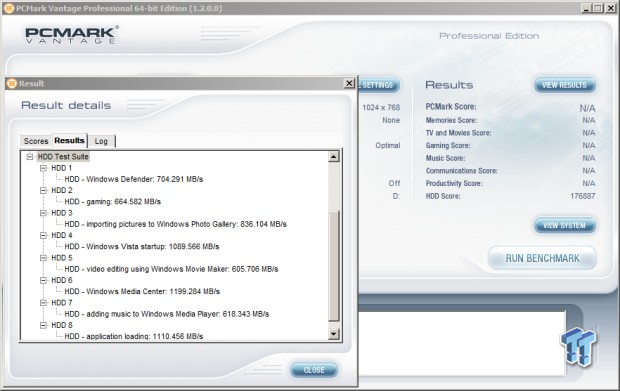
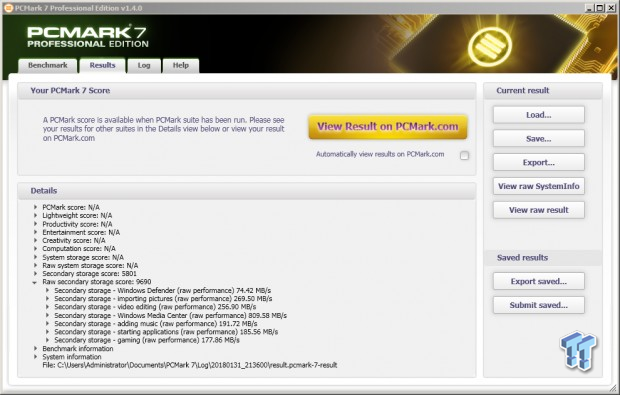
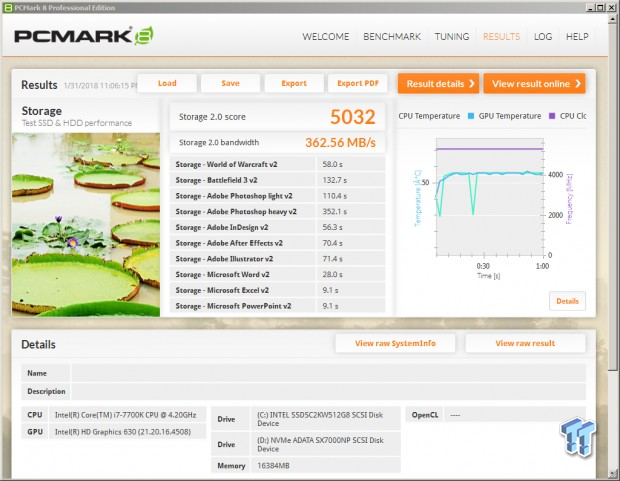
Final Thoughts
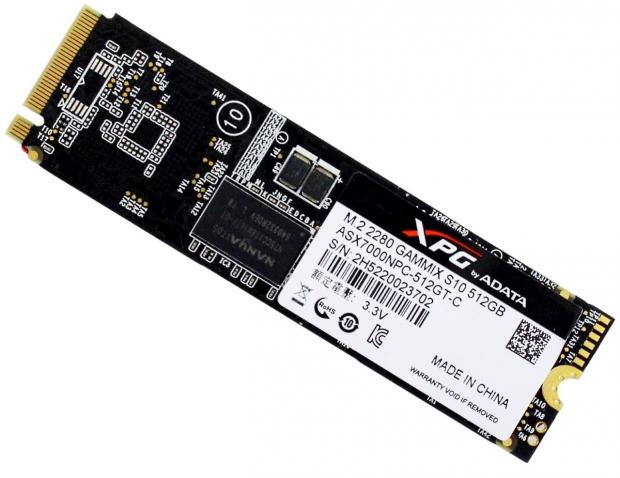
We have a tendency to value performance above all, because it is exciting. To gain a proper perspective on ADATA's XPG Gammix S10, we need to take a step back from our enthusiast views and see the XPG Gammix S10 for what it brings to the table. The XPG Gammix S10 actually represents what most everyday consumers are looking for. Fast enough, good quality and the best value available.
The XPG Gammix S10 delivers to the consumer the lowest cost 4-lane NVMe SSD on the market. The XPG Gammix S10 has all the latest features, like LDPC ECC, SLC caching, data shaping, and a RAID engine for the ultimate in data protection. When you buy an XPG Gammix S10, you get more than just a capable drive, you get two great value adds - Acronis cloning software and ADATA's comprehensive SSD Toolbox.
Too top it off, the XPG Gammix S10 is in our opinion the best-looking M.2 solution on the market. The thin but substantial and very functional aluminum heat sink really brings the bling while providing on average 10c lower temps. Even the packaging is top notch. You can feel the quality in your hand. Additionally, ADATA backs the XPG Gammix S10 with an industry leading 5-year warranty.
In terms of value, the XPG Gammix S10 checks all the boxes. In terms of performance the XPG Gammix S10 isn't going to light the world on fire. But for most, the performance delivered is more than sufficient for most. The XPG Gammix S10 is much faster than SATA SSDs for everyday use, faster (and significantly cheaper) than Intel's popular 600p and it comes in the most popular form-factor - M.2 x 2280. No data or power cables, it just integrates onto your motherboard with a single screw.
In terms of user experience, the S10 Gammix delivers the goods quite well. The speed and responsiveness it delivers over SATA is noticeable from the first time you boot. Overall, we are pleased with the time we spend running the XPG Gammix as our system disk. With these things in mind, ADATA's XPG Gammix S10 is TweakTown recommended.
Pros:
- Overall Value
- Sleek Design
- Lowest Price Point
Cons:
- Random Read Performance

| Performance | 85% |
| Quality | 97% |
| Features | 95% |
| Value | 100% |
| Overall | 94% |
The Bottom Line: For the average user, ADATA's XPG Gammix S10 represents the best 4-lane value on the market today.
PRICING: You can find products similar to this one for sale below.
 United
States: Find other tech and computer products like this
over at Amazon.com
United
States: Find other tech and computer products like this
over at Amazon.com
 United
Kingdom: Find other tech and computer products like this
over at Amazon.co.uk
United
Kingdom: Find other tech and computer products like this
over at Amazon.co.uk
 Australia:
Find other tech and computer products like this over at Amazon.com.au
Australia:
Find other tech and computer products like this over at Amazon.com.au
 Canada:
Find other tech and computer products like this over at Amazon.ca
Canada:
Find other tech and computer products like this over at Amazon.ca
 Deutschland:
Finde andere Technik- und Computerprodukte wie dieses auf Amazon.de
Deutschland:
Finde andere Technik- und Computerprodukte wie dieses auf Amazon.de
What's in Jon's PC?
- CPU: AMD Ryzen 7800X 3D
- MOTHERBOARD: GIGABYTE AORUS Master X670E
- RAM: Kingston Fury Renegade 7200MHz 32GB
- GPU: ZOTAC AMP Extreme GeForce RTX 4090
- SSD: Crucial T700 2TB Gen5
- OS: Windows 11 Pro
- COOLER: Lian Li Galahad 360 AIO
- CASE: Lian Li Lancool III
- KEYBOARD: Corsair K65 RGB Mini
- MOUSE: SteelSeries AEROX 5 Wireless
- MONITOR: ASUS ROG Strix PG27AQN 360Hz 1440p ULMB2
Similar Content
Related Tags

